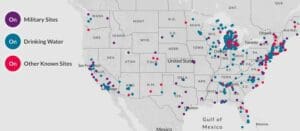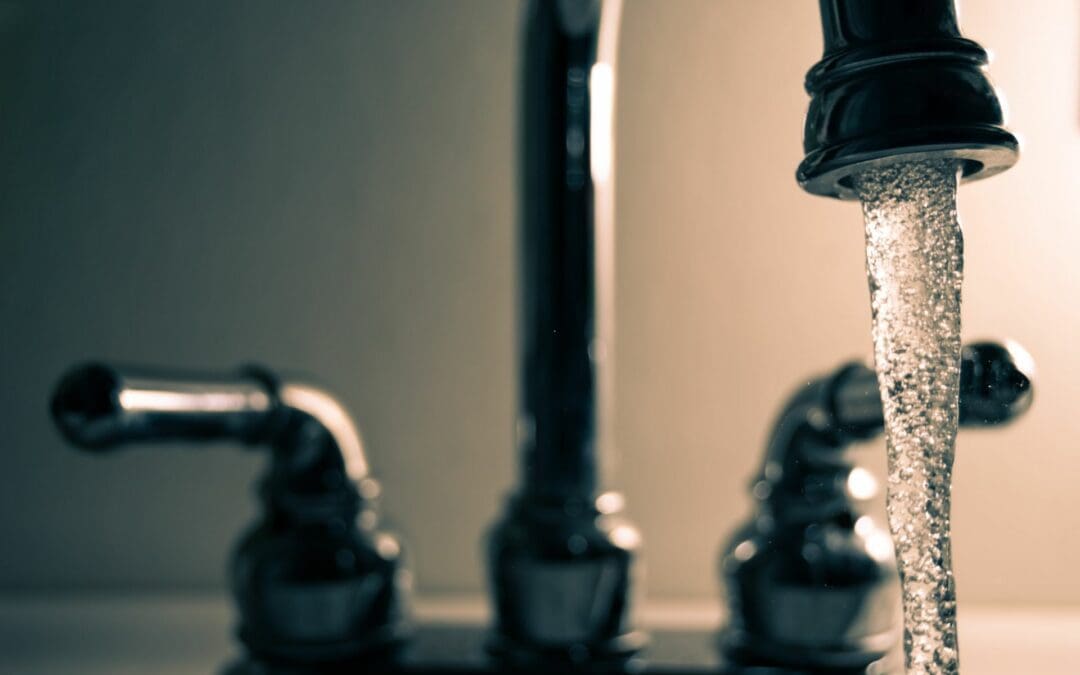All over the country, PFAS is being discovered in groundwater and other sources that feed into municipal water supplies. These chemicals have been used heavily since the 1940’s. Since PFAS are not biodegradable, contamination has built up over time and causes adverse health effects.
FreshPure Waters proudly uses proven technology to remove PFAS. Easy and convenient to pick up while you do your grocery shopping, FreshPure Waters ensures you and your family drink clean, safe, pure water.
What is PFAS?
PFAS (Per- and Polyfluoroalkyl Substances) is a classification of chemicals that contains carbon and fluorine. It includes PFOA, PFOS, GenX, and other emerging contaminants. There are hundreds of known PFAS compounds. PFAS are used in the manufacturing of a wide range of materials, including:
- Food packaging
- Non-stick and products like Teflon
- Water-Repellant products like waxes and paint
- Fire-fighting foam
“Per- and polyfluoroalkyl substances (PFAS) are a group of man-made chemicals that includes PFOA, PFOS, GenX, and many other chemicals. PFAS have been manufactured and used in a variety of industries around the globe, including in the United States since the 1940s. PFOA and PFOS have been the most extensively produced and studied of these chemicals. Both chemicals are very persistent in the environment and in the human body – meaning they don’t break down and they can accumulate over time. There is evidence that exposure to PFAS can lead to adverse human health effects.”
Adverse Health Effects of PFAS
Exposed populations have shown higher instances of:
- Increased cholesterol levels
- Decreased infant birth weights
- Effects on the immune system
- Cancer (for PFOA)
- Thyroid hormone disruption (for PFOS)
How does it get in our Water supply?
PFAS seeps into groundwater near production facilities that use PFAS, landfills, airports, and military bases. The most prevalent cause of PFAS contamination is fire-fighting foam. Since airports and military bases both use a high amount of fire-fighting foam in training and operations, they represent the majority of contamination sites. Communities near production facilities that use PFAS, such as Wilmington, NC which lies 100 miles downstream from DuPont’s Chemours, are also impacted. The EPA’s Consumer Confidence Reports on local water supply are available to the public. You may also look up state water records through the Environmental Working Group.
PFAS Hot Spots
Check out this map from the Environmental Working Group to see if you live in an affected area of the country.
How do you remove PFAS from Drinking Water?
According to the EPA and University of Massachusettes, granular activated carbon (GAC), high pressure membranes like reverse osmosis and nanofiltration, and ion exchange resins are effective ways to remove PFAS.
Since “GAC works well on longer-chain PFAS like PFOA and PFOS, but shorter chain PFAS like Perfluorobutanesulfonic acid (PFBS) and Perfluorobutyrate (PFBA) do not adsorb as well,” FreshPure Waters uses both GAC and Reverse Osmosis in order to remove PFAS of varying sizes.
Ion exchange resins are used to make FreshPure Deionized Water, effectively using all three filtration methods proven to remove PFAS from our water.
Third party tests show that FreshPure Waters removes GenX and other PFAS.
What is being done to fix this?
As is the case with most emerging contaminants, research comes before action, and that takes time. City and State level action steps to clean up PFAS are much faster. Here is a brief overview.
Federal Action:
In 2016, the EPA established a PFAS guideline, however it is not an official Maximum Contamination Level and therefore cannot be not enforced. “In June 2018, the CDC released a draft report warning that PFAS chemicals could pose a health risk at levels lower than what is currently recommended by the EPA.” In response to health concerns associated with high levels of PFAS in local water supply, “…many states and towns have questioned the level or have set their own, stricter rules.”
The EPA is scheduled to determine whether or not to set Maximum Contamination Limits on PFAS by the end of 2019. However, the EPA is facing criticism on moving too slowly to set nationwide PFAS regulations. In an effort to push the EPA forward, Congress has created a bipartisan task force. The group includes House members who are facing PFAS contamination in their own communities and have seen the effects first hand at the local level.
State Action:
Since water is not the only concern, PFAS bans are beginning to emerge. Washington state, for example, will eventually ban PFAS use for food packaging and fire-fighting foam.
City-Level Action:
Cities like Ann Arbor, Michigan are taking major action by funding the clean-up of their water supply.
In the meantime, FreshPure Waters offers clean, safe, PFAS-free water right now in your local natural foods stores.
Source List:
https://www.npr.org/2018/10/02/651180024/decades-old-chemicals-new-angst-over-drinking-water
https://ag.umass.edu/cafe/fact-sheets/activated-carbon-treatment-for-drinking-water-supplies
https://www.ncbi.nlm.nih.gov/books/NBK234593/
https://www.huffpost.com/entry/pfas-chemicals-drinking-water-study_n_5cd1f18ae4b0a7dffcce0257
https://www.michiganradio.org/post/pfas-where-have-they-been-found-public-water-supplies
https://www.mlive.com/news/2019/03/ann-arbor-spends-1-million-to-deal-with-pfas-contamination.html
